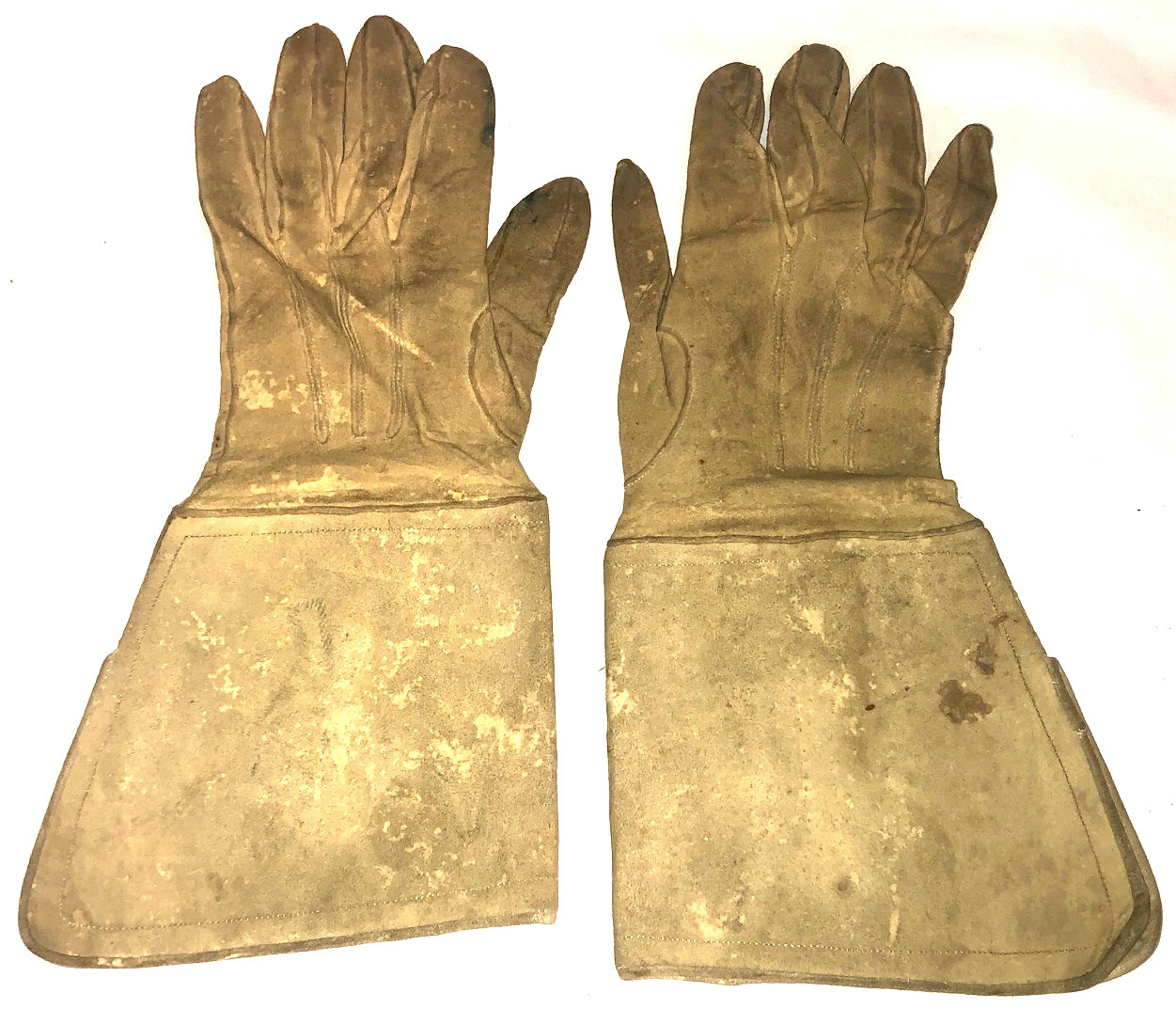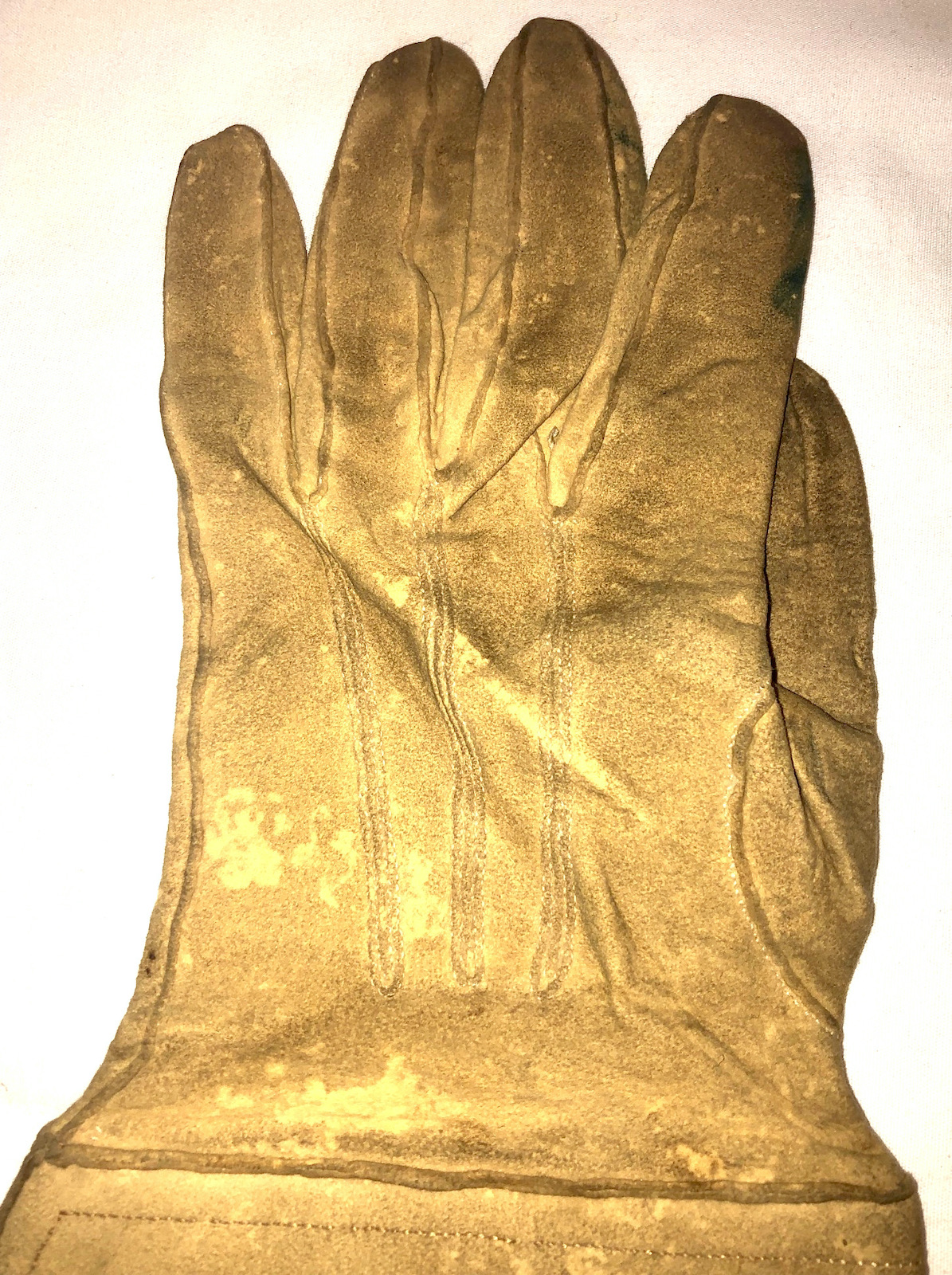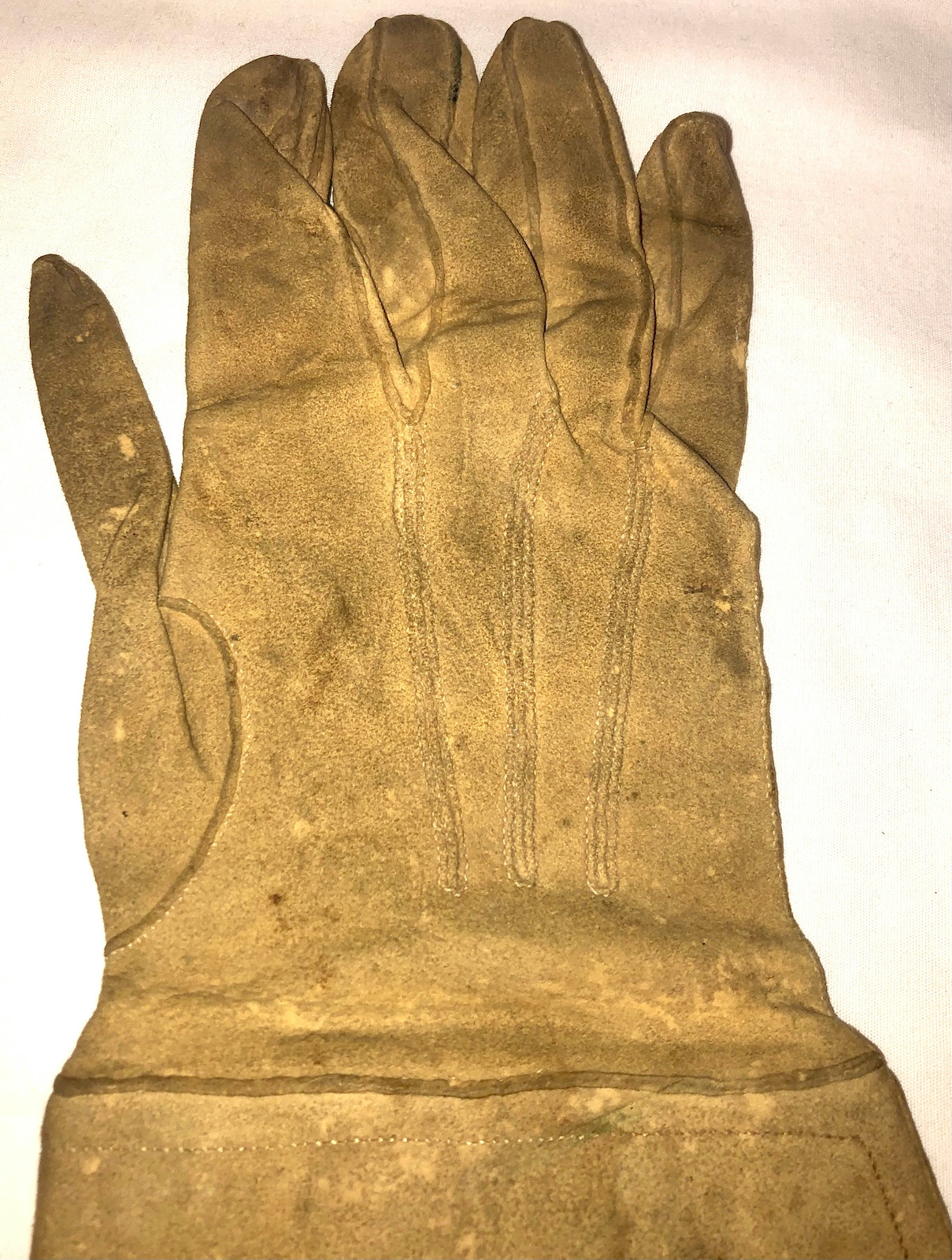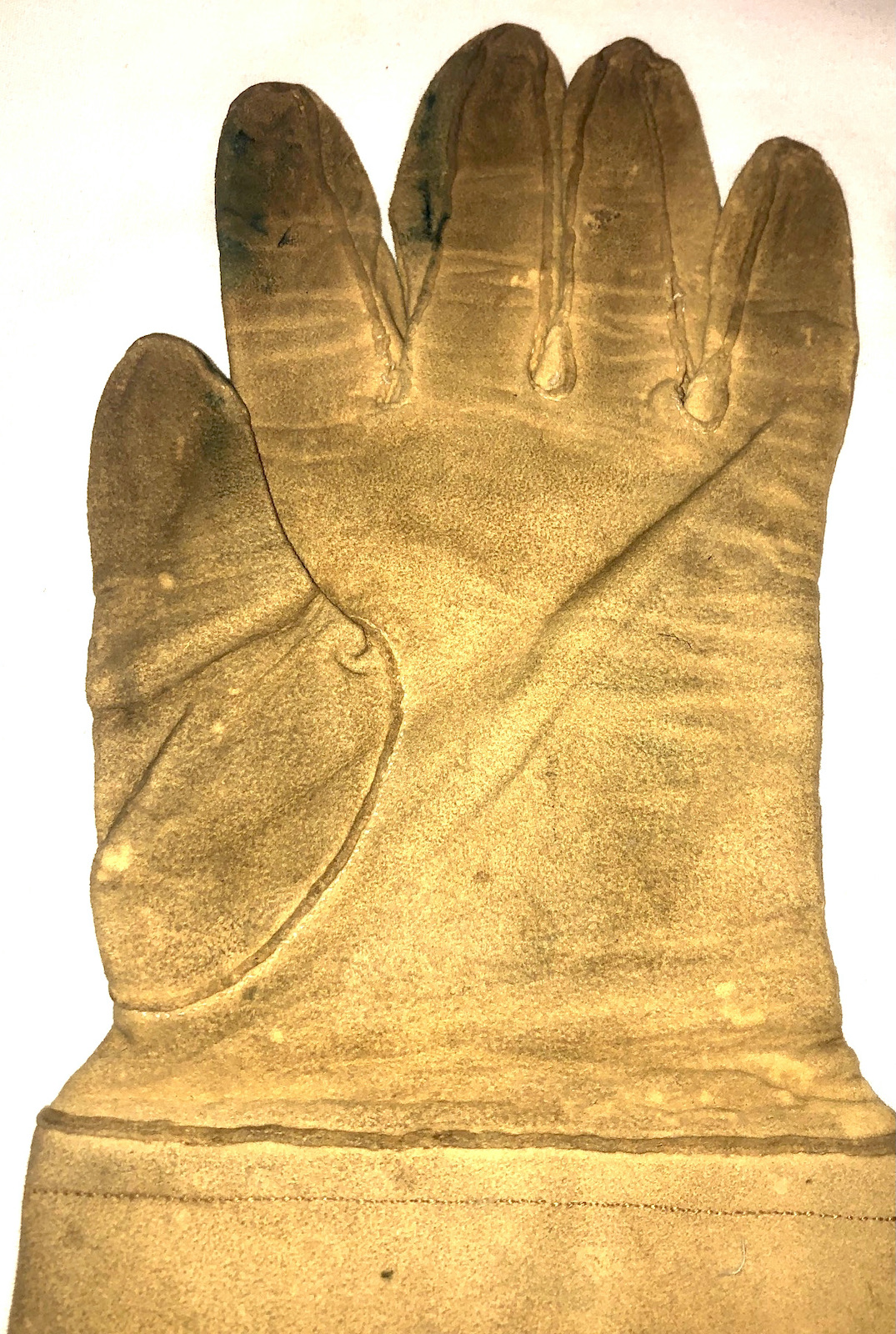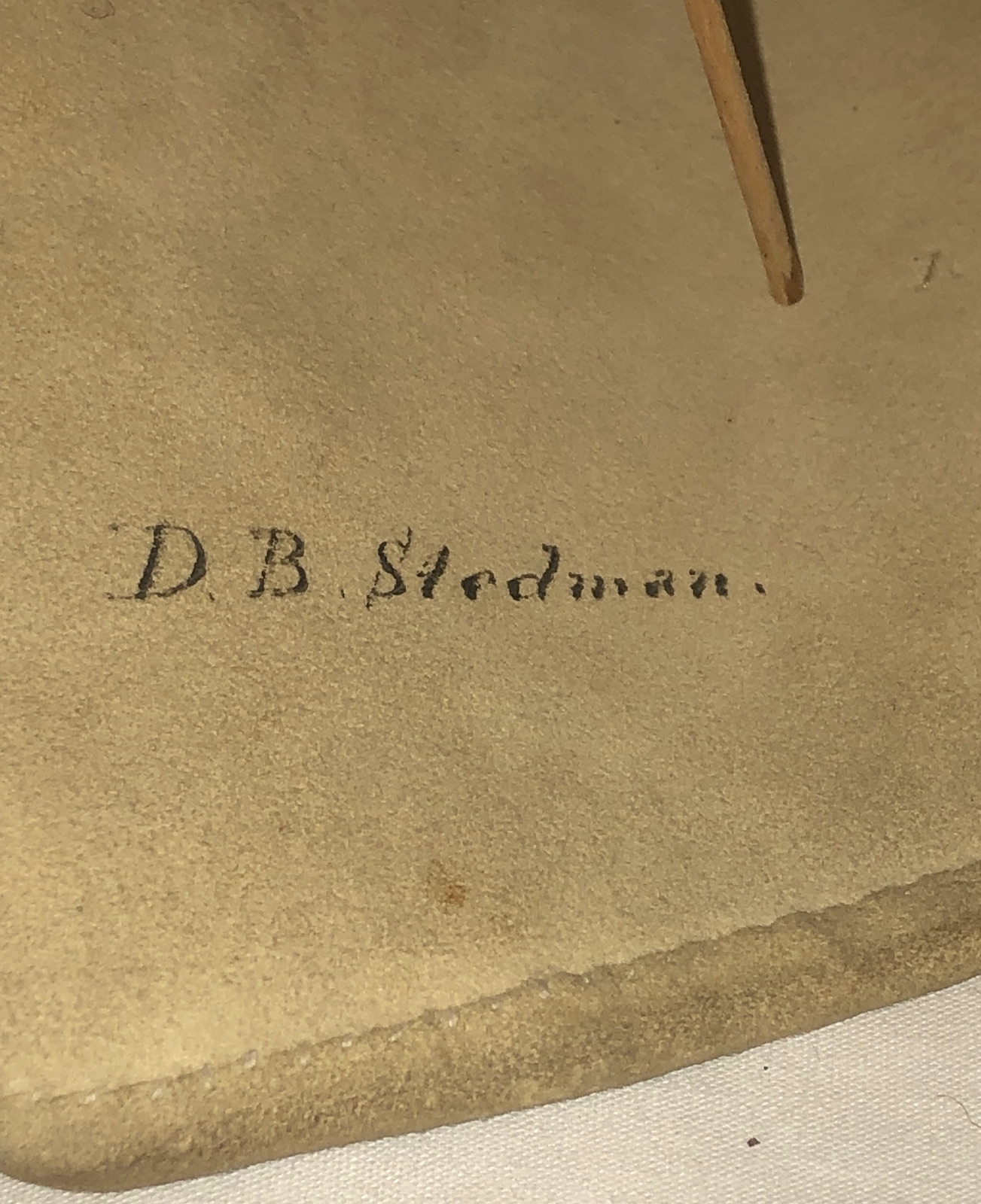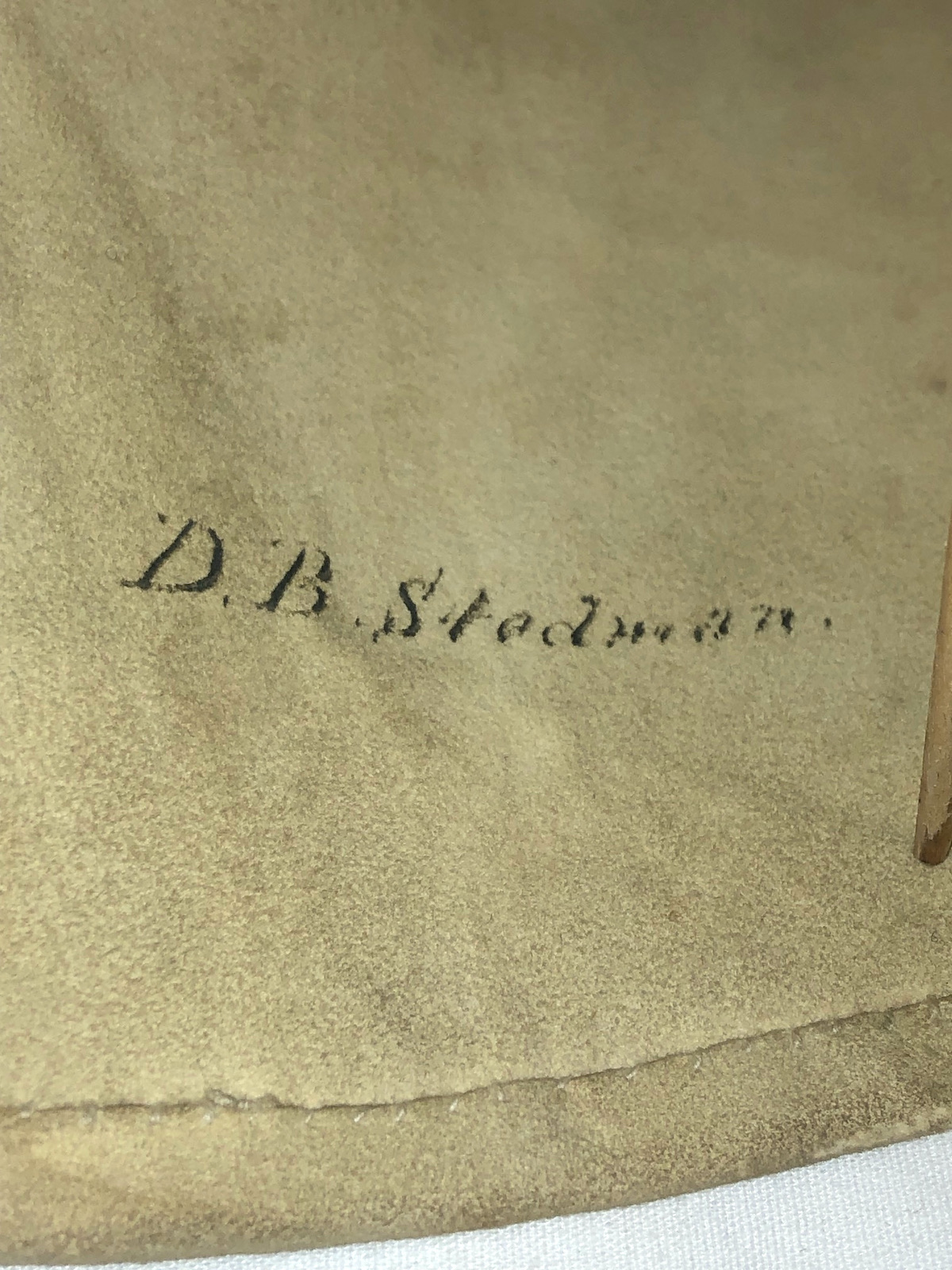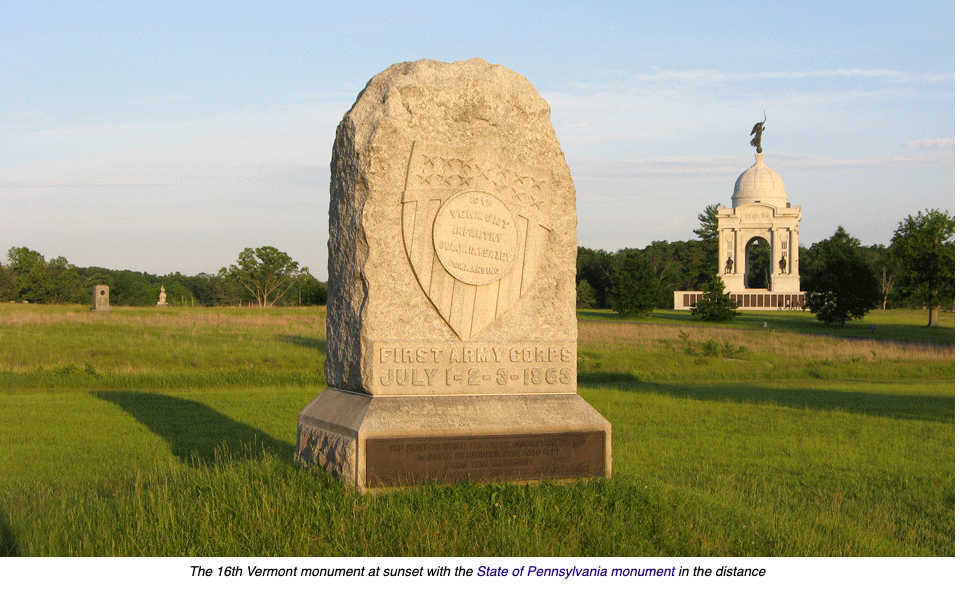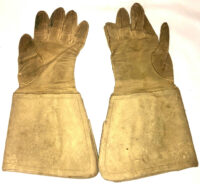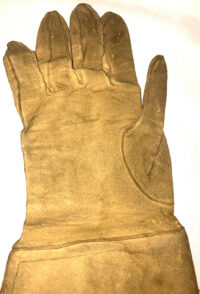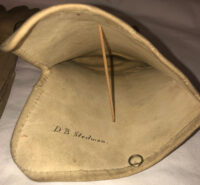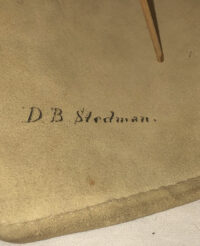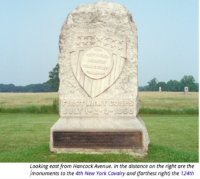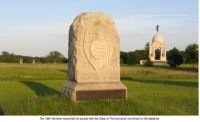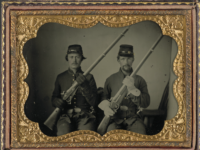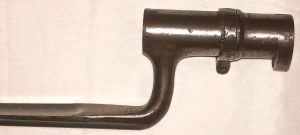Id’d Pair of Civil War Gauntlets – Private Daniel Bissell Stedman Co. B 16th Vermont Infantry
SOLD
Id’d Pair of Civil War Gauntlets – Private Daniel Bissell Stedman Co. B 16th Vermont Infantry – Original Civil War gauntlets have always been difficult to find; we have had two or three pairs, but they remain an elusive collectible. This pair, which remains in fine condition, have the name “D.B. Stedman” hand-inked in the interior cuffs of both right and left gauntlets. Stedman enlisted, in Brattleboro, Vermont, in August, 1862, as a Private; he was promoted to the rank of Corporal in February, 1863. Stedman’s regiment, the 16th Vermont, was a nine-month regiment, that actually saw action at Burke’s Station, repulsing a raid initiated by Gen. JEB Stuart, on December 28, 1862 and a skirmish at Catlett’s Station, on May 30, 1863. The regiment would see considerable action during the Battle of Gettysburg, most notably on July 3, 1863, holding down the left flank of the Union line, during Pickett’s Charge. During the course of that action, the 16th Vermont captured the flag of the 11th Virginia infantry; Private Stedman sustained a wound during this engagement. The gauntlets are constructed of a fine quality, mellow, buff goatskin and exhibit a combination of hand and treadle-machine stitching. Stitched inside the cuff of each gauntlet is a brass “bachelor ring”, often encountered attached to the shanks of war period buttons, allowing them to be removed from a uniform or vest for polishing; we presume that Private Stedman may have had these rings placed on his gauntlets to allow him to tie them to his belt, to prevent their loss. This is a fine pair of Civil War gauntlets, worn by a Vermont infantry Corporal, wounded at Gettysburg, during Pickett’s Charge.
Daniel B. Stedman
| Residence Brattleboro VT;
Enlisted on 8/28/1862 as a Private. On 10/23/1862 he mustered into “B” Co. VT 16th Infantry He was Mustered Out on 8/10/1863 at Brattleboro, VT He was listed as: * Wounded 7/3/1863 Gettysburg, PA Promotions: * Corpl 2/14/1863 Other Information: Member of GAR Post # 16 (E. K. Wilcox) in Springfield, MA died 10/7/1923 After the War he lived in Brattleboro, MA
|
16th VT Infantry
( 9-mos )
| Organized: Brattleboro, VT on 10/23/62 Mustered Out: 8/10/63 at Brattleboro, VTOfficers Killed or Mortally Wounded: 1 Officers Died of Disease, Accidents, etc.: 1 Enlisted Men Killed or Mortally Wounded: 23 Enlisted Men Died of Disease, Accidents, etc.: 48 (Source: Fox, Regimental Losses) |
| From | To | Brigade | Division | Corps | Army | Comment |
| Oct ’62 | Feb ’63 | 2 | Casey’s | Military District of Washington | New Organization | |
| Feb ’63 | Apr ’63 | 2 | Casey’s | 22 | Department of Washington, D.C. | |
| Apr ’63 | Jun ’63 | 2 | Abercrombie’s | 22 | Department of Washington, D.C. | |
| Jun ’63 | Aug ’63 | 3 | 3 | 1 | Army of Potomac | Mustered Out |
VERMONT
SIXTEENTH REGIMENT.
(NINE MONTHS.)
| BY CORPORAL CHANDLER M. RUSSELL, COMPANY F,
And SERGEANT LYMAN S. EMERY, COMPANY A SIXTEENTH REGIMENT. THE Sixteenth regiment of Vermont Volunteers was composed of companies which were recruited in the counties of Windsor and Windham. These companies met and organized at their respective places of rendezvous between the dates of August 26 and September 20, 1862, as follows: Company A–at Bethel; Henry A. Eaton, Captain.
Company B–at Brattleboro; Robert B. Arms, Captain.
Company C–at Ludlow; Asa G. Foster, Captain.
Company D–at Townshend; David Ball, Captain.
Company E–at Springfield; Alvin C. Mason, Captain.
Company F–at Wilmington; Henry F. Dix, Captain.
Company G–at Barnard; Harvey N. Bruce, Captain.
Company H–at Felchville; Joseph C. Sawyer, Captain.
Company I–at Williamsville; Lyman E. Knapp, Captain.
Company K–at Chester; Samuel Hutchinson, Captain.
On the 27th of September, 1862, the officers of these companies met at Bellows Falls and elected the field officers of the regiment, as follows: Wheelock G. Veazey of Springfield, Colonel; Charles Cummings of Brattleboro, Lieutenant-Colonel; William Rounds of Chester, Major; Jabez D. Bridgman of Rockingham, Adjutant; James G. Henry of Royalton, Quartermaster; Dr. Castanus B. Park, Jr., of Grafton, Surgeon; Dr. George Spafford of Windham, Assistant Surgeon; Rev. Alonzo Webster of Windsor, Chaplain. This regiment rendezvoused at Brattleboro on the 9th of October, 1862, and was mustered into the United States service on the 23d of October, 1862, by Major William Austine, with 949 officers and men, and a more intelligent and educated body of men, it is safe to say, was never mustered for any regiment. The regiment left Brattleboro for the seat of war on the 24th of October, 1862, by way of New Haven Connecticut, over the Sound Line of Steamers to New York, thence to Port Monmouth by boat, and then by rail the balance of the way to Washington, where it arrived on the morning of October 27. It went into camp on Capitol Hill near where the Twelfth, Thirteenth, Fourteenth and Fifteenth regiments, which had just preceded it, were in camp, and with which it was brigaded, forming what was known as the Second Vermont Brigade. On the 30th of October the regiment moved across the Potomac River and encamped with the rest of the brigade near Ball’s Cross Roads in Virginia. This place was called “Camp Seward.” The regiment remained at this camp until November 3, when it moved to a high ridge overlooking the Potomac River and near Hunting Creek, a distance of about nine miles. The whole brigade moved at the same time to the same place, and from that time on the place was called Camp Vermont. It was expected that the regiment would remain at this place during the winter as a part of the reserve force for the defense of Washington, and considerable pains were taken to stockade and make camp life comfortable, but on the 11th of December the brigade was ordered to move, and on the following day did move out farther to the front. The first night it encamped at Fairfax Court House and the next day moved on to a point near Centreville, where it remained, doing picket duty for several days, and then returned to Fairfax Court House and remained there until January 20, 1863. The regiment then moved to Fairfax Station on the Orange and Alexandria railroad and remained there until the 24th of March, and then moved down the railroad about six miles on a high point near Union Mills. The principal service while here was picket duty on Bull Run, and at points farther down the railroad, which was being repaired and opened for transportation to the Rappahannock River. May 27 the regiment was ordered to guard the railroad, and companies A and G, in command of Captain Eaton, were stationed at Manassas Junction, and companies C, D, E and F, with Colonel Veazey and Major Rounds, were stationed at Bristoe Station, near Broad River, and companies B, I and K, with Lieutenant-Colonel Cummings in command, were stationed at Catlett’s Station. May 30 a supply train was attacked by a party of raiders under Mosby and considerable damage done. A short skirmish occurred and the raiders were driven back. On the 11th of June the regiment returned to Union Mills and resumed picket duty along Bull Run. On the 23d the brigade, which had been commanded since April 20 by General Stannard, became attached to the First Corps of the Army of the Potomac under General Reynolds. The Confederates had already started on their raid toward Pennsylvania and a heavy battle was imminent. On the 25th orders came to move and the pickets on duty were called in. Colonel Veazey called his officers and non-commissioned officers together and assured them that they might soon expect to meet the enemy in battle, and gave them good advice and instructions. At 3 o’clock of that day, the regiment started on its march, joining the great tide of the Army of the Potomac, which was moving northward to intercept the enemy in its advance on Washington, Baltimore, Harrisburg and Philadelphia. The Potomac was crossed at Edward’s Ferry and the great army passed on through Adamstown, Frederick, Jeffersonville and other towns. On the 30th, after a forced march of six days in heavy marching order, the regiment reached Emmitsburg, and a rest was taken there for the night. About ten o’clock the next morning the sound of battle was heard in the direction of Gettysburg, and the regiment moved on at noon in that direction as rapidly as possible. The weather was intensely hot, the men were weary and foot-sore, but every man readily and quickly fell into line. The usual hilarity of a start did not prevail, but instead each man’s face bore a grave, determined look. At 5 o’clock the regiment was in full view of the terrible scene. Shells bursting in the air, smoke of burning buildings, the roar of artillery, wounded men being borne to the rear, citizens of the town and vicinity fleeing for their lives, cast a gloom over the men, but the ranks gathered up closer and the sturdy men commenced nerving themselves for the emergency. As the regiment neared the battlefield, a halt was made, the guns and ammunition were inspected, bayonets fixed, and the regiment started at a rapid pace, sometimes at double-quick, and soon formed in the battle line upon the ridge, a little to the left of Cemetery Hill. The first day’s fight was just over, and our troops had been forced back through the town upon this ridge and hill. About one-third of the Sixteenth regiment, under command of Major Rounds, was detailed for picket duty that night, and the remainder took position on the rear slope of Cemetery Hill and bivouacked for the night, which all with reason apprehended would be the last night on earth of more or less of our number. In the morning, July 2, the pickets were recalled, but during the forenoon, company B, Captain Arms, was sent forward to re-enforce the skirmish line, and there rendered splendid service. This company was taken into position by Captain Foster of company C, who was then on General Stannard’s staff, and was wounded in discharging this duty. The main battles of July 2 were fought on the right and left flanks of the Union line. Near the close of the battle on the left, which had been fought with the greatest severity and had finally involved several Corps of the Union Army, the Sixteenth, with the rest of the brigade, was moved about one-half mile to the left along Cemetery Ridge to re-enforce our badly shattered lines. In this movement it was under terrific artillery fire, one shell hitting two men and killing them instantly. The regiment was finally halted in support of a battery and just in season to receive and repel a heavy charge of infantry. Darkness soon came on and the battle ceased with the Sixteenth in the front line. Soon after this Colonel Veazey was detailed to take the regiment with others and establish a picket line across the battlefield of that afternoon. The battle had been fought back and forth over this ground and it was literally covered with dead and wounded men, among whom the Sixteenth were deployed to watch the enemy while our army was resting for a renewal of the awful conflict in the morning. No regiment ever had a more trying night on picket duty. It was not relieved in the morning, but the men held the same position as skirmishers throughout the forenoon and until the final assault. The position of the reserves, supporting the skirmish line, was twenty rods or more in advance of the main line of battle, and the skirmish line was considerably in advance of the reserves and extended a long distance to the right and left. The famous infantry charge of July 3 was preceded for two hours by the great artillery duel, participated in by some 250 guns, the regiment being in the depression between the two lines of cannon. This was followed by the charge of Longstreet’s three divisions, Pickett’s leading the same and striking first the skirmish line of the Sixteenth regiment. Pursuant to previous orders of our colonel, the skirmishers rallied on the reserves, except company G, which was so far to the right that it was obliged to retire to the main line of battle in another direction, where it opportunely met company B, which had not rejoined the regiment after it was detached the day before, as above explained, and these two companies under Captain Arms took position in support of a battery and there fought valiantly through the battle. There were, therefore, but eight companies occupying the advanced position of the reserves and towards which Pickett’s division of the enemy seemed to be directed, but as they were approaching within rifle range the enemy changed its direction to its left and sufficiently to uncover our direct front and began to pass by our right flank. Our colonel then moved us to the right and changed our front so as to be at right angles with the main line, and we assaulted Pickett’s right flank. During this movement we fired directly into the rebel flank and advanced a distance to the right of about a thousand yards, and continued the charge until Pickett’s division had mainly disappeared, a great proportion being killed, wounded or captured. At this moment, another rebel line appeared off to our left and was apparently aiming in the direction of the position we held before making this charge to the right. This new force turned out to be Perry’s and Wilcox’s brigades. Colonel Veazey immediately got the regiment into line, began a movement back over the same ground we had just passed, and again changed our front so as to be again at right angles with the main line of battle, but facing to the left instead of the right, and just as those two brigades reached the point from which we had started he ordered us to charge their flank, which we did with a cheer and followed it a long distance until that line had wholly disappeared, and this was the end of the battle of Gettysburg, with our regiment still holding its original extreme advanced position, having captured prisoners many times its own number and three stands of colors. The regiment suffered considerable loss in killed and wounded, but much less than would be expected from its participation at the pivotal point of the battle far in advance of any other troops of the Union line, and where the collision of the fighting was probably as severe and stubborn as ever occurred in battle; but the comparatively small loss under the circumstances was due to the fact that the regiment was constantly on the move in charging flanks to the right and left and so was not exposed to the direct front fire of the enemy’s infantry lines. The conspicuous part it took in this great battle, its size and bearing in the conflict at a trying and critical period, its skillful management by Colonel Veazey, won for it and its gallant and much beloved commander a conspicuous place in the annals of the war. After the battle, Colonel Veazey being put in command of the brigade, it joined in the pursuit of Lee’s forces until they had crossed the Potomac back into Virginia, and then, as the term of enlistment of the regiment had expired, it started toward home, arriving in New York City when the draft riot was at white heat, and it volunteered to remain there until order was restored. It camped upon the Battery, lying upon its arms and ready for any emergency. No disturbance, however, called it into action. From there it returned to Brattleboro, Vermont, and was mustered out August 10, 1863, with 831 officers and men. The history of this regiment would hardly be complete without a brief reference to its commander. Col. Wheelock G. Veazey was born at Brentwood, New Hampshire, December 5, 1835. He graduated at Dartmouth College, and later at the Albany Law School, and had just commenced the practice of law at Springfield, Vermont, when the war commenced. He enlisted early in the war as a private in the Third Vermont regiment, was made captain of company A of that regiment, and soon promoted to Major and Lieutenant-Colonel. He was in the Peninsular Campaign under General McClellan, and participated in the many battles of that campaign. For a while he was on the staff of Gen. W. F. Smith, better known as Gen. “Baldy” Smith. The Sixteenth regiment was therefore fortunate in having as its commanding officer one whose experience in the field had equipped him so thoroughly for this command. He succeeded well in winning the confidence of the officers and men and to an eminent degree won their universal love and respect. After the war Colonel Veazey served conspicuously as lawyer, legislator, supreme court judge, and in many other positions of public trust, and resigned his office as Judge to accept an appointment by President Harrison as Interstate Commerce Commissioner, which position he now holds. The veteran soldiers have honored him in many ways, and especially when the great order of the Grand Army of the Republic elected him Commander in Chief at Boston in 1890. His administration in that capacity was signally able and successful, and marked an era of prosperity in that noble order. ENGAGEMENTS.
Burke’s Station, Va., (Repulse of Stuart’s Raid), Dec. 28, 1862. Catlett’s Station, Va., May 30, 1863. Gettysburg, Pa., July 1, 2 and 3, 1863. Gettysburg after battle report: Report of Col. Wheelock G. Veazey, Sixteenth Vermont Infantry. Hdqrs. Sixteenth Vermont Volunteers, Camp at Berlin, Md., July 17, 1863. Capt.: I have the honor to report the following as the part taken by the Sixteenth Regt. Vermont Volunteers in the battle of Gettysburg, fought July 1, 2, and 3, 1863: The regiment arrived on the field near the close of the action of the first day, but was not engaged. On the morning of the second day the regiment was moved to the rear of Cemetery Hill, and remained there in column, closed in mass (except Company B, Capt. Armes, which was moved forward to the skirmish line at 4.30 p. m.), until about 5 p. m., when it was moved to the left about 100 rods, and forward to the crest of the hill, and there deployed in support of the batteries engaged. In this movement the regiment was under a severe fire, and several men were killed and wounded. Later still it was moved farther to the left and forward, and when the battle closed it occupied the front line of battle. Soon after dark I was detailed as general field officer of the day, and the whole regiment was detailed for picket duty. On the morning of the third day, at a quarter before 4 o’clock, the enemy engaged the left of the picket line, and at 4 a. m. opened with their artillery, which was replied to by a battery on the elevated ground in our rear, firing over our heads. This fire continued but a short time. At about 2 p. m. the enemy again opened with their artillery severely. They are reported to have had over one hundred pieces in our front. This continued for about two hours. At about 4 p. m. the enemy advanced a line of battle against my picket line with great vigor. The pickets stood firm and opened fire upon them. The Fourteenth Vermont was moved down to the right of my reserves, which consisted of six companies. Two of the other four companies were on the picket line before they rallied on the reserves, and two (B and G) were in support of a battery. The Thirteenth Vermont moved forward to the right of the Fourteenth and a little to the rear of their line, and the three regiments opened a rapid and destructive fire upon the right of the line of the enemy (Pickett’s division), which soon diverged to their left, and thereby left their right flank exposed. Pursuant to an order to me, the Sixteenth Regt. passed back and along by the rear of the Fourteenth and moved to the left of the Thirteenth, and, joining on to the left of that regiment, changed front forward, corresponding to a like movement of the Thirteenth, and the two regiments charged into the flank of the enemy and very soon crushed the force in our new front. Very many prisoners were taken in this charge. This line of the enemy had scarcely been destroyed before another line advanced farther to the left and obliquely to my rear. I immediately received an order to march back and get into position to oppose this new line. I moved about 15 rods by marching by the left flank and filing to the left, so as to gain upon the enemy and bring my front facing obliquely to his left flank. When this position was gained I received permission to charge. The result of this charge was a very large number of prisoners, and, in the two movements, three stand of colors, the colors being stripped from one standard. The two brought in were the Second Florida and the Eighth Virginia. The former had inscribed upon it “Williamsburg” and “Seven Pines.” No further demonstrations were made by infantry in our front, but my regiment suffered severely from artillery after we had destroyed their infantry lines. I could not speak too highly in praise of the conduct of both officers and men. I know of no instance of a man leaving the ranks until disabled. I regret to mention as one of the killed Lieut. Lawton, Company F. He was a young man of great fidelity and bravery, to whom I was much attached. He fell mortally wounded near the close of the battle. A list of the killed and wounded is hereto attached.* Respectfully submitted. W. G. VEAZEY, Col., Comdg. Sixteenth Regt. Vermont Vols. Capt. W. H. Hill, Assistant Adjutant-Gen. |
Colonel: Wheelock Graves Veazey
Lieutenant Colonel: Charles Cummings
Major: William Rounds
The 16th Regiment, composed of men from Windsor and Windham counties, was organized Sep. 27, 1862, rendezvoused at Brattleboro Oct. 9, and was mustered into the United States service for nine months on the 23d. It was one of the five nine months’ regiments recruited in Vermont under the call of Aug. 4, 1862, for 300,000 militia. Col. Veazey, a graduate of Dartmouth College, had received excellent training in military affairs as captain, major and lieutenant-colonel in the 3d Vt. infantry, and as commander of the 5th Vt., during part of the Peninsular Campaign. He was an excellent officer and commanded the complete confidence of his regiment. LtCol Cummings had served as first lieutenant of Co. E of the 11th Vt., afterwards returned to the service as lieutenant-colonel of the 17th Vt. and was killed while commanding that regiment at the battle of Poplar Grove, near Petersburg, Va. Maj. Rounds was a well-known lawyer of the Windsor County bar, but without previous experience in military affairs. The regiment had an unusually large number of intelligent and well-educated men and contained some of the best blood of the state. It left Brattleboro on Oct. 24, 1862, with 949 officers and men, for Washington, and on its arrival, there was brigaded with the other Vermont troops to form the 2nd Vermont Brigade. On Oct. 30, it moved with the brigade, to Ball’s cross-roads, Va., and then to Hunting creek, where it established “Camp Vermont.” On Dec. 11, it moved farther to the front and was stationed at Centerville and Fairfax Court House until Jan. 20, 1863. It was then at Fairfax Station on the Orange & Alexandria railroad until March 24, when it moved to Bull Run and was chiefly occupied in guard and picket duty. In the latter part of May it was stationed by detachments at various points on the railroad on guard duty. At Catlett’s station, on May 30, Mosby’s raiders attacked a supply train and inflicted considerable damage. On June 11 it returned to Union mills and resumed picket duty along Bull Run. Lee’s great invasion into Pennsylvania was now under way, and on June 23 the brigade, commanded by Gen. Stannard, was assigned to the 1st corps of the Army of the Potomac. Two days later it received orders to join the corps and started on its long, forced march to Gettysburg. It reached Emmitsburg, Md., on the 30th and after a hurried march the following day reached the battlefield at the close of the first day’s fight, going into position on the left on Cemetery hill. The regiment was engaged on the afternoon of the 2nd, Co. B, under Capt. Arms being detached to reinforce the skirmish line in the morning and rendering efficient service. While moving in the afternoon to the left along Cemetery ridge to reinforce the shattered Union lines, it was exposed to a heavy artillery fire, and finally halted in support of a battery. That night it was detailed for picket duty across the field of the afternoon and during the fierce fighting of the 3d day, it held the same advanced position on the skirmish line. During the famous charge of Longstreet’s three divisions the 16th was heavily engaged, twice changing front under a severe artillery and musketry fire and charging the enemy’s flank. It captured prisoners several times in excess of its own numbers, together with 3 stands of colors, and after the battle followed in pursuit of Lee’s retreating army until Lee crossed the Potomac into Virginia, when it was ordered home, its term of enlistment having expired. It arrived in New York during the draft riots and remained there until order was restored. It was finally mustered out at Brattleboro, Aug. 10, 1863.
The total enrolment of the 16th was 968, of whom 24 were killed in action or mortally wounded; 48 died of disease and 1 died in prison – total deaths, 73. Eighty men were wounded, 4 were captured and 2 deserted.
From the monument at Gettysburg:
16th Vermont Infantry,
Colonel W. G. Veazey commanding
First Army Corps
July 1-2-3-1863
Participated near this point in action of July 2nd
Picketed this line that night – held same as skirmishers
until attacked by Pickett’s Division, July 3rd.
Rallied here and assaulted his flank to the right 400
yards – then changing front charged left flank of Wilcox’s
and Perry’s brigades. At this point captured many hundred prisoners and two stands of colors
The point to which the above inscription refers
is south 58 degrees, west 1000 feet
from this monument
and near the northerly end of the Codori thicket
Location of the monument
The monument to the 16th Vermont Infantry is south of Gettysburg on the east side of Hancock Avenue about 190 yards north of Pleasonton Avenue.
About the monument to the 16th Vermont
The granite monument stands just over 9′ tall. The front features a relief of a United States Shield overlaid with the regiment’s information. A brass tablet at the base of the monument is inscribed with the regiment’s actions at Gettysburg.
The monument was originally dedicated in September of 1892 by the State of Vermont, placed in the Codori thicket about 1000 feet west of the monument’s present location. This was where the regiment attacked Wilcox’s Brigade in the aftermath of Pickett’s Charge on July 3rd. In 1901 the monument was relocated to the current, more visible and accessible location.
The 16th Vermont at the Battle of Gettysburg
Colonel Wheelock G. Veazey commanded the 16th Vermont at the Battle of Gettysburg. The regiment brought 661 men to the field, losing 16 killed, 102 wounded and 1 missing. It had spent most of its nine month enlistment in the Washington defences and guarding rail lines. The 16th was ordered to join the Army of the Potomac on June 25th, and reached Gettysburg on the evening of the 1st of July.
The regiment performed well in counterattacking the Confederate assault on the afternoon of July 2nd. But its most brilliant action was during Pickett’s Charge on the 3rd. As Kemper’s Virginians angled north toward the Copse of Trees the 16th swung out from its position on Cemetery Ridge and tore into their flank. Then the regiment turned around and attacked the flank of Perry’s Florida Brigade, which had been sent to support Pickett.
Like the rest of the Second Vermont Brigade, the 16th was back in Vermont and mustered out to civilian life within a few weeks.
| Colonel Wheelock Veazey earned the Medal of Honor for his actions at the Battle of Gettysburg on July 3rd. The citation reads: “Rapidly assembled his regiment and charged the enemy’s flank; charged front under heavy fire, and charged and destroyed a Confederate brigade, all this with new troops in their first battle.” |
| Attached to the 3rd Brigade, 3rd Division, 1st Corps, Army of the Potomac |
Daniel Bissell Stedman
BIRTH
13 Jul 1840
DEATH
7 Oct 1923 (aged 83)
BURIAL
Brattleboro, Windham County, Vermont, USA



